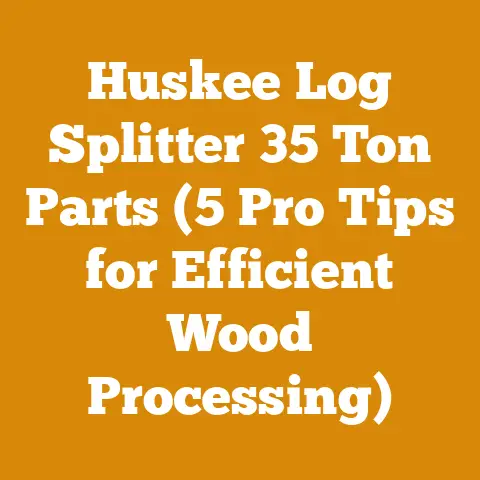Lumber Drying Shed Tips (5 Essential Air-Drying Techniques)
Imagine this: You’ve just felled a beautiful oak tree, its wood grain promising warmth and character. The feeling is exhilarating, right? But now what? You can’t just throw those green logs into your fireplace and expect a cozy evening. They’ll hiss, smoke, and deliver little heat. That’s where proper lumber drying comes in. More specifically, creating a lumber drying shed and employing effective air-drying techniques.
I remember my first attempt at drying lumber. I stacked the freshly sawn boards neatly in my backyard, covered them with a tarp, and figured I was golden. Months later, I was greeted with warped, moldy, and utterly useless wood. A costly and frustrating lesson! That’s why I’m writing this guide. I want to share what I’ve learned over the years about building a proper lumber drying shed and mastering the art of air-drying, so you can avoid similar pitfalls and transform your green lumber into valuable, usable wood.
The global wood processing and firewood industry is a significant one. Did you know that the global firewood market alone is projected to reach over $10 billion by 2027? And while modern heating systems are prevalent, firewood remains a crucial energy source for many, especially in rural areas. Equally, the demand for quality, seasoned lumber for construction, woodworking, and other crafts remains high. However, successfully navigating this landscape requires knowledge and skill, especially regarding drying lumber.
Let’s dive into the essential air-drying techniques and the secrets to building a lumber drying shed that will make your wood seasoning dreams a reality.
Lumber Drying Shed Tips (5 Essential Air-Drying Techniques)
Why Bother with Air-Drying? The Benefits Unveiled
Before we get our hands dirty, let’s understand why air-drying is such a crucial step. Green wood, freshly cut, can contain upwards of 50% moisture content, sometimes even more depending on the species. This excess moisture makes the wood heavy, unstable, and prone to fungal growth and insect infestations.
Air-drying, on the other hand, gradually reduces the moisture content to a level that’s in equilibrium with the surrounding environment, typically between 12% and 20% depending on your climate. This process offers several key advantages:
- Reduced Warping and Cracking: As the wood dries slowly, internal stresses are minimized, leading to less warping, twisting, and cracking.
- Enhanced Stability: Seasoned wood is more dimensionally stable, meaning it’s less likely to shrink or swell with changes in humidity.
- Increased Strength: Drying increases the strength and stiffness of the wood.
- Improved Workability: Dry wood is easier to saw, plane, sand, and finish.
- Resistance to Decay: Lower moisture content makes the wood less susceptible to rot and insect damage.
- Cost-Effective: Air-drying is a relatively inexpensive method compared to kiln drying, requiring minimal energy input.
Building Your Lumber Drying Shed: A Step-by-Step Guide
Now, let’s get down to business. A well-designed lumber drying shed is the cornerstone of successful air-drying. It provides protection from the elements while allowing for adequate airflow.
1. Location, Location, Location!
- Choose a well-drained site: Avoid areas prone to flooding or standing water. Excess moisture around your shed will significantly hinder the drying process.
- Consider prevailing winds: Orient the shed to take advantage of natural breezes, which will help circulate air through the stacks of lumber.
- Shade is your friend: Direct sunlight can cause uneven drying and surface checking. A location with partial shade is ideal. If full sun is unavoidable, consider adding shade cloth to the shed’s exterior.
- Accessibility matters: Make sure the location is easily accessible for loading and unloading lumber, especially if you’re dealing with heavy logs.
2. Shed Design and Construction
I’ve seen sheds range from simple lean-tos to elaborate, fully enclosed structures. The best design for you will depend on your budget, space, and climate. Here are a few key considerations:
- Size: Determine the size of the shed based on the volume of lumber you plan to dry at any given time. As a general rule, err on the side of larger rather than smaller. You’ll always find a use for extra space!
- Frame: A simple post-and-beam frame is a sturdy and cost-effective option. Use treated lumber for ground contact to prevent rot.
- Roof: A pitched roof is essential for shedding rain and snow. Consider using metal roofing for durability and longevity. Ensure adequate overhang to protect the lumber stacks from direct rain.
- Walls: The walls are crucial for controlling airflow. Avoid solid walls; instead, opt for open sides or walls with adjustable vents. This allows you to fine-tune the ventilation based on weather conditions. I often use horizontal slats spaced a few inches apart. This provides good airflow while still offering some protection from the elements.
- Floor: A gravel floor is a good option for drainage and to prevent weed growth. You can also use concrete or wood, but make sure to provide adequate drainage.
Data Point: Studies have shown that sheds with well-ventilated walls and roofs can reduce drying time by up to 30% compared to poorly ventilated structures.
3. Stacking Lumber for Optimal Airflow: The Art of Sticker Placement
Proper stacking is perhaps the most critical aspect of air-drying. The goal is to create consistent airflow around each board, allowing for even drying. This is where “stickers” come in.
- What are stickers? Stickers are thin strips of wood (typically 1″ x 1″ or 3/4″ x 3/4″) used to separate the layers of lumber in a stack.
- Sticker material: Use dry, uniform stickers made from a species that is less prone to staining the lumber you are drying. Poplar, basswood, or soft maple are good choices. Avoid using green stickers, as they can promote mold growth.
- Sticker placement:
- Place stickers directly above each other in vertical alignment. This ensures that the weight of the stack is evenly distributed, preventing warping.
- Space stickers every 12 to 24 inches, depending on the thickness and species of the lumber. Thicker lumber requires closer spacing.
- Place stickers near the ends of the boards to prevent end checking (cracking).
- Use a level to ensure that each layer of lumber is perfectly flat.
- Stack foundation: Build a solid foundation for your lumber stack using treated lumber or concrete blocks. This will keep the lumber off the ground and prevent moisture from wicking up. Ensure the foundation is level.
- Stack orientation: Orient the stack so that the boards are aligned with the prevailing winds.
- Stack height: Limit the height of the stack to prevent excessive weight on the lower boards.
Case Study: I once helped a local woodworker diagnose a warping issue in his lumber stack. He had used uneven stickers and had not aligned them properly. By re-stacking the lumber with proper sticker placement, we were able to salvage most of the wood. This highlights the importance of paying attention to detail during the stacking process.
4. Monitoring Moisture Content: Knowing When It’s Done
Knowing when your lumber is dry enough is crucial. You can’t rely on guesswork. You need to monitor the moisture content regularly using a moisture meter.
- Types of moisture meters:
- Pin-type meters: These meters use two pins that are inserted into the wood to measure electrical resistance, which is correlated to moisture content. They are relatively inexpensive and accurate.
- Pinless meters: These meters use radio frequency signals to measure moisture content without penetrating the wood. They are more expensive but offer the advantage of non-destructive testing.
- How to use a moisture meter:
- Follow the manufacturer’s instructions carefully.
- Take readings at multiple points in the stack, including the center boards.
- Allow the meter to acclimate to the temperature of the wood before taking readings.
- Target moisture content: The ideal moisture content for most woodworking applications is between 6% and 8%. For outdoor projects, a slightly higher moisture content (12% to 15%) is acceptable. For firewood, below 20% is ideal.
- Drying time: Drying time varies depending on the species of wood, thickness of the lumber, climate, and airflow. It can take anywhere from several months to a year or more to properly air-dry lumber. Patience is key!
Data Point: A study by the USDA Forest Service found that air-drying oak lumber from 80% moisture content to 20% moisture content can take up to 12 months in some climates.
5. Essential Air-Drying Techniques: Beyond the Basics
While building a proper shed and stacking the lumber correctly are crucial, there are a few additional techniques that can significantly improve your air-drying results.
- End Coating: Apply an end coating to the ends of the boards to prevent end checking. This is especially important for hardwoods like oak and maple. You can use a commercial end coating product or a mixture of paraffin wax and mineral spirits.
- Weighting the Stack: Place weights on top of the stack to help prevent warping. Concrete blocks or heavy timbers work well.
- Turning the Stack: Periodically turn the stack to ensure even drying. This is especially important for thicker lumber.
- Species-Specific Considerations: Different wood species dry at different rates and have different tendencies to warp or crack. Research the specific characteristics of the wood you are drying and adjust your techniques accordingly. For example, oak is notoriously slow to dry and prone to checking, while pine dries relatively quickly.
- Climate Control (If Possible): While air-drying is primarily a natural process, you can enhance it with some climate control measures, especially in humid environments. A dehumidifier placed inside the shed can help reduce moisture levels and speed up the drying process. Even a simple fan can significantly improve airflow.
Chain Saws, Axes, and Wood Species: A Deeper Dive
Let’s talk tools and wood. Choosing the right tools for felling trees and processing logs is essential for efficient and safe lumber drying. And understanding the properties of different wood species is crucial for predicting their drying behavior and end-use suitability.
Chain Saws vs. Axes: The Right Tool for the Job
- Axes: Axes are great for smaller trees and for splitting firewood. They require more physical effort but are less noisy and don’t require fuel. They are also excellent for limbing smaller branches. I still use an axe for splitting smaller logs. There’s something deeply satisfying about it!
- Chain Saws: Chain saws are the go-to tool for felling larger trees and bucking logs into manageable lengths. They are powerful and efficient but require proper maintenance and safety precautions.
Choosing the Right Chain Saw:
- Engine Size: For small trees and occasional use, a small to medium-sized chain saw (30-40cc engine) is sufficient. For larger trees and more frequent use, a larger saw (50cc or more) is recommended.
- Bar Length: Choose a bar length that is slightly longer than the diameter of the largest trees you plan to fell.
- Safety Features: Look for chain saws with safety features such as a chain brake, anti-vibration system, and throttle lock.
Safety First! Always wear appropriate safety gear when using a chain saw, including a helmet, eye protection, hearing protection, gloves, and chaps.
Understanding Wood Species
Different wood species have different properties that affect their drying behavior, strength, and durability. Here are a few examples:
- Oak: Strong, durable, and resistant to decay. Slow to dry and prone to checking. Excellent for furniture, flooring, and outdoor projects.
- Maple: Hard, dense, and fine-grained. Dries relatively well but can be prone to warping. Excellent for furniture, flooring, and musical instruments.
- Pine: Soft, lightweight, and easy to work with. Dries quickly but is less durable than hardwoods. Excellent for construction, paneling, and furniture.
- Cherry: Beautiful reddish-brown color and fine grain. Dries well and is relatively stable. Excellent for furniture and cabinetry.
- Walnut: Rich dark brown color and beautiful grain. Dries slowly but is very stable. Excellent for furniture, gun stocks, and high-end woodworking projects.
Data Point: The density of wood is a key factor in determining its drying time. Denser woods, like oak and maple, take longer to dry than less dense woods, like pine and poplar.
Costs, Budgeting, and Resource Management
Let’s be realistic. Building a lumber drying shed and air-drying lumber involves costs. Here’s a breakdown of potential expenses and tips for managing your resources:
- Shed Materials: Lumber, roofing, hardware, concrete blocks. The cost will vary depending on the size and complexity of your shed.
- Tools: Chain saw, axe, moisture meter, measuring tools, safety gear.
- Stickers: Lumber for stickers.
- End Coating: Commercial end coating product or materials for making your own.
- Electricity (If Applicable): For dehumidifier or fans.
- Labor: Your time and effort.
Budgeting Tips:
- Shop around for materials: Compare prices at different lumberyards and hardware stores.
- Consider using reclaimed materials: You can often find used lumber and roofing materials at a fraction of the cost of new materials.
- Build the shed yourself: This will save you money on labor costs.
- Start small: You don’t need to build a huge shed right away. Start with a smaller structure and expand as needed.
Resource Management Tips:
- Use sustainable forestry practices: Harvest trees responsibly to ensure the long-term health of the forest.
- Minimize waste: Use lumber efficiently and recycle or compost any scraps.
- Conserve energy: Use energy-efficient tools and appliances.
Troubleshooting and Common Pitfalls
Air-drying lumber is not always a smooth process. Here are some common problems you might encounter and how to address them:
- Warping: Caused by uneven drying. Ensure proper sticker placement and weight the stack.
- Checking: Cracking on the ends of the boards. Apply an end coating.
- Mold and Mildew: Caused by excessive moisture. Improve ventilation and consider using a dehumidifier.
- Insect Infestation: Treat the lumber with a borate solution to prevent insect damage.
- Staining: Caused by certain types of stickers or contact with metal. Use dry, uniform stickers made from a species that is less prone to staining.
Real Example: I once had a stack of cherry lumber develop a severe mold problem due to poor ventilation. I had to dismantle the stack, clean each board with a bleach solution, and re-stack it with improved airflow. It was a time-consuming process, but I was able to salvage most of the lumber.
Next Steps and Additional Resources
Congratulations! You’ve now learned the essential techniques for building a lumber drying shed and air-drying lumber. Here are some next steps you can take:
- Start Planning Your Shed: Design your shed based on your needs and available resources.
- Gather Materials: Purchase the necessary materials for building your shed and stacking lumber.
- Start Drying! Follow the techniques outlined in this guide to air-dry your lumber successfully.
- Continue Learning: There’s always more to learn about wood processing and firewood preparation. Read books, watch videos, and attend workshops to expand your knowledge.
Additional Resources:
- USDA Forest Service: Provides information on wood properties, drying techniques, and sustainable forestry practices.
- Local Lumberyards: Can provide advice on wood species, drying schedules, and local climate conditions.
- Woodworking Clubs: Connect with other woodworkers and share your experiences and knowledge.
- Logging Tool Suppliers: Baileys, Northern Tool, Forestry Suppliers.
- Drying Equipment Rental Services: Check your local rental companies for dehumidifiers and other climate control equipment.
Final Thoughts
Air-drying lumber is a rewarding process that allows you to transform raw wood into valuable material for your projects. It requires patience, attention to detail, and a willingness to learn. But with the right knowledge and techniques, you can successfully air-dry lumber and enjoy the beauty and versatility of wood for years to come. So, go forth, build your shed, stack your lumber, and embrace the art of wood seasoning! And remember, a well-seasoned piece of wood is a woodworker’s best friend.






